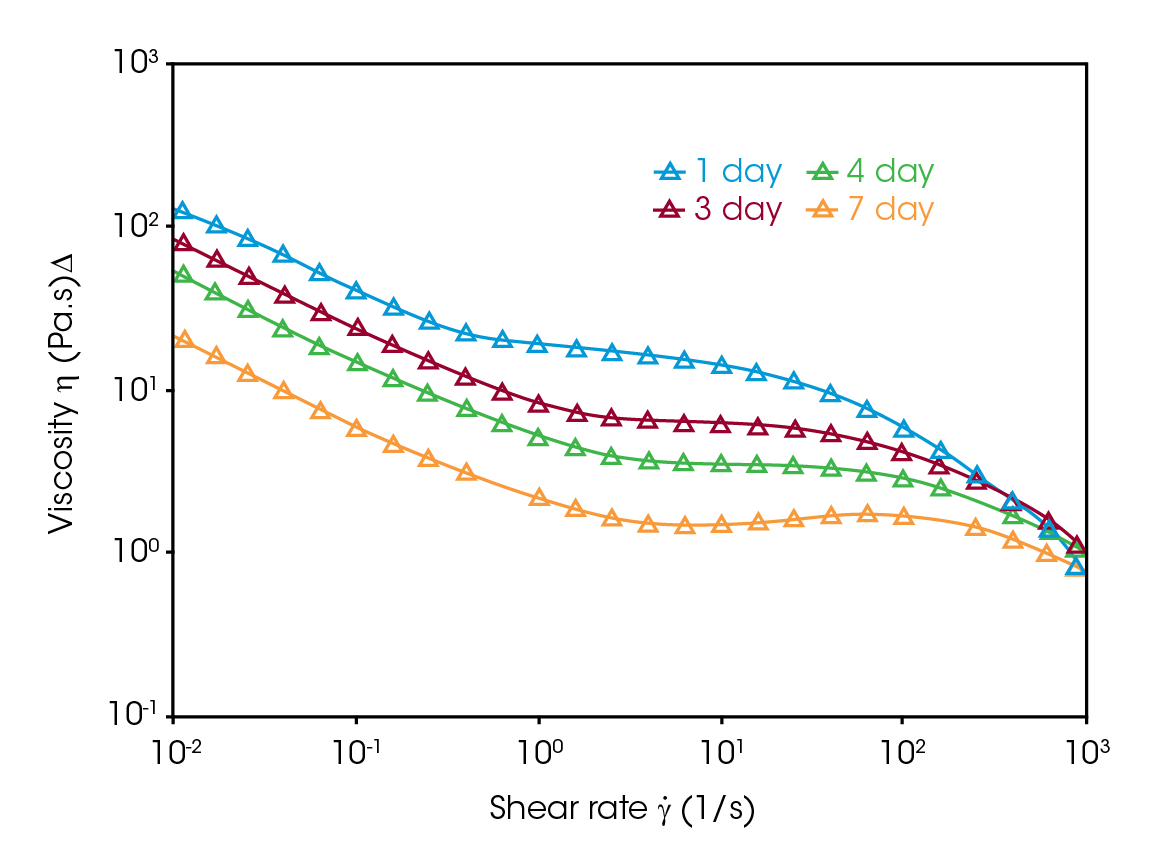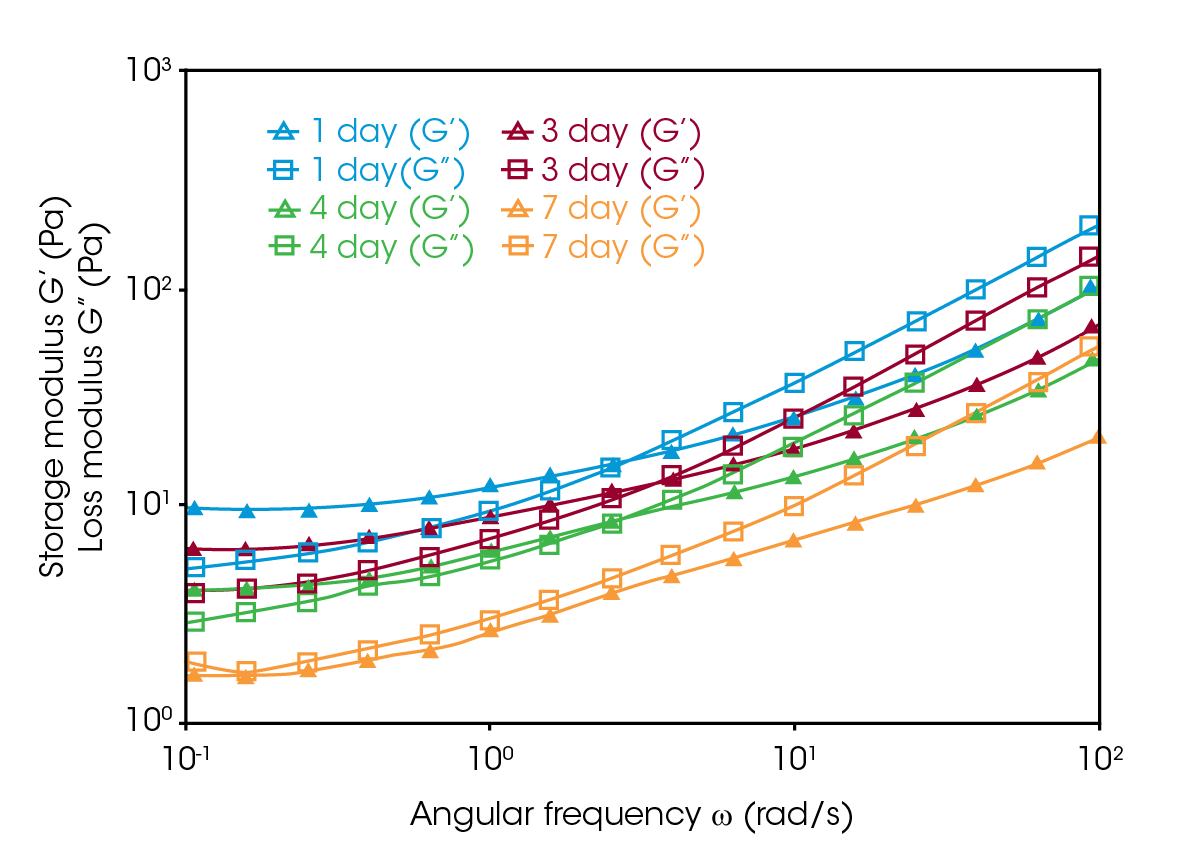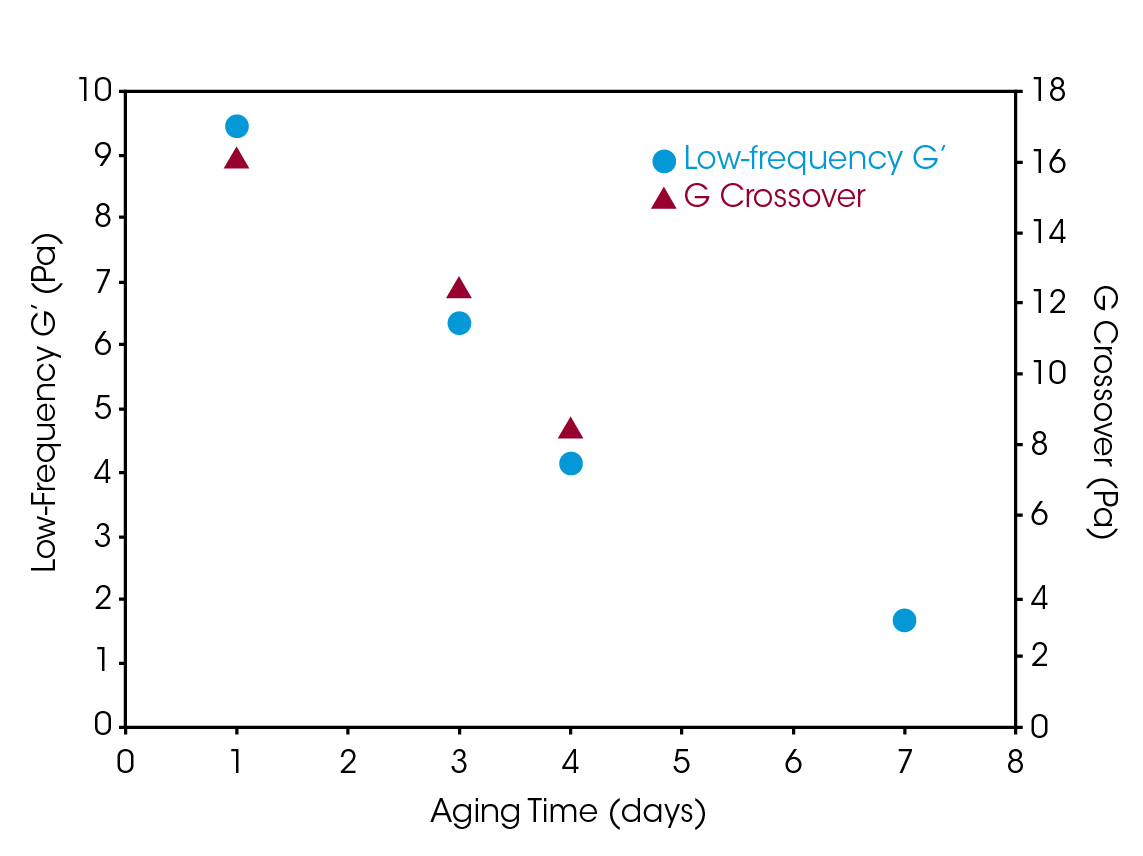Keywords: Rheology, Lithium-ion battery, Anode slurry
RH130
Abstract
Battery solvents have come under increased pressure and regulation due to their negative environmental impact, forcing manufacturers to identify more sustainable practices. A focus has been on electrode solvents, where much of the battery manufacturing cost is attributed to the resource-intensive solvent drying and recovery process. As companies look toward more environmentally compatible and cost reducing processes, it is critical they understand the impact of new materials to the overall slurry stability and coating process. This application note will investigate the slurry aging and stability through its flow behavior and viscoelastic properties by using rheological methods. The slurry studied demonstrates a decrease in stability over time, which can be used to indicate the appropriate batch lifetime in a production environment.
Introduction
Lithium-ion batteries (LIBs) have evolved as the primary energy storage option for a range of applications, from consumer electronics to electric vehicles [1] . While the battery industry is leading the charge in future energy storage solutions, there are still obstacles in the manufacturing processes for batteries. These challenges include reducing manufacturing costs, optimization of components, homogenous and consistent mixing of components, sustainability challenges, and high volumes of intermediate materials such as organic solvent. Government regulations are also increasingly restricting the use of harmful materials. There is currently a significant effort to reduce or replace the common organic solvents used in electrode slurry processing such as N-Methylpyrrolidone (NMP) to achieve manufacturing sustainability and reduce costs [2] . NMP is used for its ability to dissolve polyvinylidene fluoride (PVDF), which is one of the most common binders used in LIBs [3] . The use of the organic solvent and processing of PVDF render this a non-sustainable manufacturing methodology. This limitation has led to the development of aqueous-based slurries that can utilize water-soluble bio-derived polymeric binders while increasing the solids content of the slurry to decrease the amount of solvent needed. A widely used and sustainable choice of binder is carboxymethyl cellulose (CMC) for aqueous based anode slurry formulation. This polymer is derived from cellulose and therefore is environmentally compatible and water soluble at low concentrations.
While the sustainability benefits of CMC aqueous-based slurries are apparent, there are practical concerns that arise with bio-based binder systems. One such consideration is the hydrolyzable nature of bio-based polymers. In CMC, hydrolysis reactions occur as a natural product from the presence of advantageous impurities such as bacteria that can breakdown the polymeric structure. These reactions can result in a structural breakdown of the weak CMC network that stabilizes the dispersion of the active material in the slurry. Rheology is an ideal option to investigate this structure and its subsequent breakdown after processing. The sensitivity of rheological measurements to weak network structures renders it superior to single-point viscometer testing, which is usually performed off-line in the battery slurry manufacturing process.
In this note, the stability of a CMC-based aqueous anode slurry is explored as a function of time. The rheological changes over time are critical for the optimal processing of the slurry. For efficient quality analysis and control (QA/QC) testing, determination of viscosity and viscoelastic behavior during the manufacturing process is very important and can be achieved on the HR series rheometers.
Experimental
The slurry used in this work is an aqueous-based anode slurry containing graphite, conducting carbon (CC), CMC, and Styrene Butadiene Rubber (SBR). Component concentration was optimized to industrially relevant concentration ratios and prepared with total solids content loading of 59 weight percent (wt.%). High solids content can be utilized to reduce cost and time in the slurry manufacturing process. This reduction in solvent will reduce cost along with drying time and allow higher throughput.
The anode slurry used in this work was formulated with raw materials provided by the NEI Corporation. The formulation consisted of 92% natural graphite, 3% CC, 1.5% CMC, and 3.5% SBR as the solids content ratio by weight percent. The SBR was supplied as a 50% dispersion in water. Briefly, the slurry was prepared by adding the CMC powder to a stir-plate and mixing it with the desired water content and the SBR dispersion. This mixture was stirred for eight hours with no added heat to avoid thermal degradation influences. The graphite and CC were then added, and the slurry was vortexed and stirred for another four hours. The slurry used was 59 wt.% solids as determined by thermogravimetric analysis using the TA Instruments™ Discovery™ TGA 5500.
The rheological measurements were conducted using a TA Instruments Discovery™ HR30 rheometer. Frequency sweeps were performed at a low strain (0.1%) that was within the linear viscoelastic region (LVR) from 100-0.1 rad/s [4] . Flow sweeps were performed from 0.01-1000 s-1 with steady state sensing selected in the TRIOS software on the sample after it was aged one, three, four, and seven days. The sample was continuously stirred using a magnetic stirrer for the time point experiments. In addition, the sample was vortexed before each test to ensure a homogenous dispersion and remove any sedimentation effects. All experiments were done with a 40 mm aluminum parallel plate and a lower Advanced Peltier Plate to hold the temperature constant at 25 °C. A test gap of 0.5 mm was used for all experiments.
Results and Discussion
Flow Behavior
To determine slurry viscosity, flow sweep tests were performed. Figure 1 shows the flow sweep data of the slurry that was aged for one, three, four, and seven days. The flow curve of the one-day slurry shows a low-shear viscosity of 132 Pa.s which is followed by subsequent shear thinning behavior. The aged slurries show a drop in the low-shear viscosity to 83.1 Pa.s, 35.7 Pa.s, and 21.4 Pa.s for the samples aged at three, four, and seven days, respectively. These results show that the slurry structures weakened over time. The same shear-thinning behavior is observed and expected as this is the same sample, but with a reduced weak network stability.
Along with shear thinning, the presence of a shear plateau feature in the mid-shear region for all the samples is observed. This indicates, in this specific formulation, that some structural formation or re-arrangement is present when sufficient shear is achieved. This structural rearrangement decreases the degree of shear thinning in the plateau region. Following the plateau, at high shear rates, there is a significant drop off for all four sample viscosities.
Due to the high solids content nature of the slurry, the possibility of shear induced structural formation is evident. The polymeric part of this dispersion constitutes 5% of the total slurry. The CMC and SBR act in concert to bind the active materials to produce a concentrated dispersion with an extremely high graphite + conducting carbon amount of 54 wt.%. Prior studies have shown that high solid content aqueous anode slurries demonstrate this mid-shear plateau [5] . This plateau can arise from shear- induced ordering within the slurry where the graphite and conducting carbon have a shear rate dependent ordering within the polymeric network. Another interesting feature is the plateau region appears to shift slightly to higher shear rates as the sample ages. Using the statistical analysis in the TRIOS software, the shift in the mid-point of the plateau regions could be quantified. The shift to higher shear was observed from 2.5, 10.0, 15.8, and 25.1 s-1 for the one-, three-, four-, and seven-day samples, respectively. The observed viscosity decrease can be attributed to an integrity loss of the polymeric structure stabilizing the dispersion. This can lead to the agglomeration of the active component. Changes in the CMC network structure have been shown to play a key role on the microstructure and flow behavior of these aqueous-based slurries previously [6] . This micro-scale structural change will manifest as a shear-dependent phenomenon as observed. From a single point viscometer, this structure change will not be observed.

Viscoelasticity
Viscoelasticity refers to the nature of a material that has properties of a liquid and a solid. For slurries used in battery manufacturing, viscoelasticity is desirable because, at times, it is beneficial for the material to flow and possess liquid-like qualities. At other times, such as after coating, possessing a more solid-like material is desired for the coating to not flow away. The dominating viscoelastic behavior is sensitive to the timescale of the process occurring to the material. Therefore, oscillation frequency sweep tests were used to examine the viscoelastic properties of the slurries.
Figure 2 shows the frequency sweep data for the four samples. Beginning with the high frequency region, the loss modulus (G”) is above the storage modulus (G’) for all the samples. This indicates a more liquid-like behavior. For time points of one, three, and four days, a modulus crossover occurs where G’ becomes greater at lower frequency, indicating a transition to a gel-like structure. This crossover point is related to the change of network structure of the materials, and it is a materials property. As seen in Figure 3, the G’ value at which this crossover occurred decreases to a lower modulus as the samples were aged. At the lowest frequency region, a plateau starts to develop in G’, which is indicative of a weak structure. The G’ of the weak network formed as a function of aging is shown in Figure 3. The sample that was aged for seven days was distinct in that no G crossover was observed, and more liquid-like behavior was present throughout the entire frequency range. This increased flowability can be problematic in the coating process where some structural recovery is desired for proper setting of the coating during drying.
The drop in the low frequency region plateau G’ also shows that while a weak network is forming, the network is losing its structural integrity as the sample ages. This network breakdown translates to a loss in slurry stability. From a QA/QC perspective, this viscoelastic information provides insight into how the slurry will behave while processing. For example, from the data above, a thicker slurry with decreased flowability will be expected for a newly prepared slurry. However, if mixing a more flowable liquid with active material, agglomerations may need to be accounted for in the manufacturing process.


Conclusions
As governments and regulations push battery manufacturers towards sustainable manufacturing, the use of aqueous-based slurries with environmentally friendly components is desirable. It is necessary to understand the impacts of formulation and processing changes on the slurries to optimize manufacturing. Rheological measurements of a high-solids content battery anode slurry containing a bio-derived binder investigated the impacts of aging on the structure and properties of the slurry. Using a Discovery HR rheometer, it was found that as the slurry aged for up to one week, the viscosity decreased, and the polymeric network integrity weakened. This network stability loss subsequently led to a change in shear-induced agglomeration between the inorganics in the slurry. The sensitivity of the instrument at low shear rates and low frequencies enabled detection of these subtle and distinct rheological property differences, making this a useful tool in QA/QC testing and slurry optimization measurements.
References
- T. Kim, W. Song, D.-Y. Son, L. K. Ono and Y. Qi, “Lithium-ion batteries: outlook on present, future, and hybridized technologies,” Journal of Materials Chemistry A, no. 7, 2019.
- S. S. Sharma and A. Manthiram, “Towards more environmentally and socially responsible batteries,” Energy and Environmental Science, vol. 13, pp. 4087-4097, 2020.
- C. M. Costa, E. Lizundia and S. Lanceros-Mendez, “Polymers for advanced lithium-ion batteries: State of the art and future needs on polymers for the different battery components,” Progress in Energy and Combustion Science, vol. 79, 2020.
- K. Whitcomb, “RH107: Determining the Linear Viscoelastic Region in Oscillatory Measurements,” TA Instruments, New Castle, DE.
- C. D. Reynolds, S. D. Hare, P. R. Slater, M. J. H. Simmons and E. Kendrick, “Rheology and Structure of Lithium-Ion Battery Electrode Slurries,” Energy Technology, vol. 10, no. 10, 2022.2.
- R. Gordon, R. Orias and N. Willenbacher, “Effect of carboxymethyl cellulose on the flow behavior of lithium-ion battery anode slurries and the electrical as well as mechanical properties of corresponding dry layers.” Journal of Materials Science, vol. 55, pp. 15867–15881, 2020.
Acknowledgement
This paper was written by Mark Staub, PhD at TA Instruments.
Click here to download the printable version of this application note.

